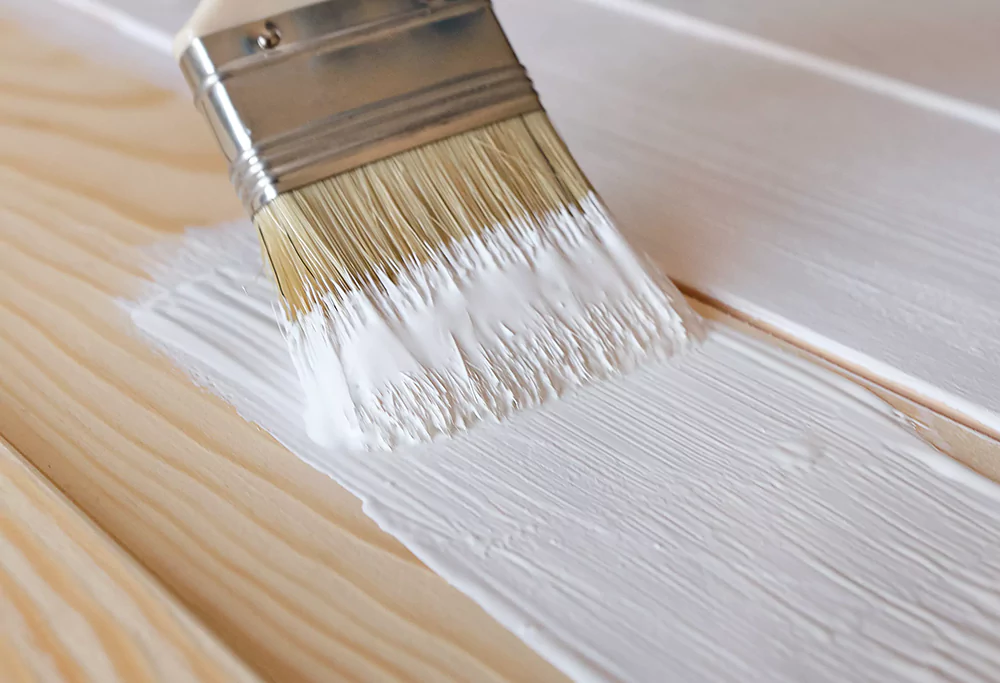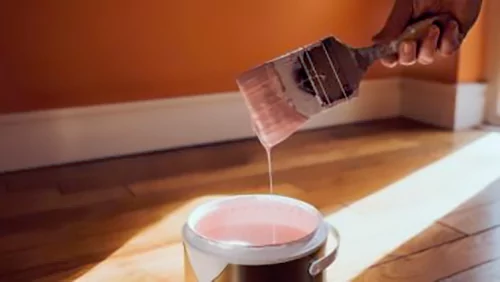Article Chapters
We have previously covered different types of water-based paints. But have you ever wondered how water-based coatings are applied? How it changes our world? Now, follow me to see how water-based coatings are applied, cleaned, diluted, and dried. Mastering these techniques will help applicators achieve beautiful results.
How to apply water based paints?
Applying waterborne coatings is not difficult, it is a joyful experience. Here is a step-by-step guide to help you apply waterborne coatings like a pro:
- Step 1: Check and Prepare
Before you begin painting, inspect the surface for any existing oil-based paint. If present, you will need to remove it to ensure proper adhesion of the water-based paint. - Step 2: Surface preparation
Improve surface smoothness by repairing any cracks, holes or imperfections. Sanding the surface can help smooth out rough areas and create a better bonding surface for water-based paint. - Step 3: Clean the Surface
Use a damp cloth or vacuum cleaner to remove all dust, dirt, and debris from the surface. A clean surface ensures that the paint adheres properly and creates a smooth surface. - Step 4: Apply Water-Based Primer
Apply a water-based primer to the surface. This not only enhances paint adhesion but also helps achieve a more even finish. Allow the primer to dry completely according to the manufacturer’s instructions. Manual brush or roller coating is usually used for interiors, and spraying processes may be used for exterior walls. - Step 5: Apply Water-Based Topcoat
Now comes the final step – applying the water-based topcoat. Use a high-quality brush or roller for best results. Start by cutting the edges with a brush, then fill in the rest of the surface with a roller for a smooth, even coat.
Other tips and tricks
- Thin Coats: It’s better to apply several thin coats of paint rather than one thick coat. This helps achieve a more even finish and reduces the risk of dripping.
- Dry between coats: Allow each coat to dry completely before applying the next. This ensures proper adhesion and prevents the paint from peeling or cracking.
- Cleaning: Clean brushes and rollers with soap and water immediately after use. This will help extend their lifespan and keep them in good condition for future use.
- Ventilate and dry: If you are working indoors. Remember to keep your home well ventilated during and after construction. Although water-based coatings are low-VOC, the additives and binders in them will always have a slight smell. This will help the paint evaporate and keep the air fresh.
By remembering these steps and tips, you can unleash your creativity and give your home a new look with water-based paint.

How to clean water based paints?
Application errors and paint spills are common occurrences when applying water based paints. For example: paint spills that leave marks on the floor, on your hands, or even on your dog. Or discovering you used the wrong water based paint! Often, we can paint over dried water based paint without having to remove it. But if your project requires it, the process is not difficult. Cleaning water based paint is a simple process.
How to remove fresh water-based coatings?
- Step 1:For paint still singing in its wet chorus, water is your knight in shining armor. Simply dampen a cloth or sponge with water and gently dab at the rogue paint. For clothing, a quick plunge under cold running water can work wonders before the paint has time to set into its final form.
- Step 2:A mild soapy water can assist in lifting the paint from surfaces without the need for an epic battle. It’s like charming the paint away with a melody only it can hear.After softening and wiping, remember to clean it again with clean water.
Please note: If you are only removing a small area, please wipe carefully during this process to reduce spread.
How to remove dried water-based paint?
If it is a high-quality water-based paint that has been applied for a long time and has completely dried and solidified, some skills are required. It is like concrete and has extremely strong adhesion after curing. But there are still ways to remove it.
- Method 1: Paint Strippers
Paint strippers are like powerful wizards that can dissolve the paint’s bond to the surface. Apply according to the potion’s—err, product’s—instructions, let it work its magic, then remove the paint with ease. Always wear gloves and work in a well-ventilated area to avoid any curses (toxic fumes). Note that you will need to rinse off all paint stripper with soapy water before starting your next coat. - Method 2: Heat Gun
A heat gun can gently warm the paint, softening it back into submission. It’s like coaxing a dragon to lower its defenses, allowing you to scrape away the paint without harming the surface beneath. Just be careful not to overheat and damage the surface underneath, and you’ll need to be careful about scraping off the paint. Don’t worry if you accidentally cause damage, you can remediate it by sanding the damaged area until it’s smooth and filling in any chips or dents before painting. - Method 3: Scrapers
With a scraper or putty knife, you can get close to scraping the dried paint. Gently push under the edge of the paint and scrape it up. This requires some patience and precision. - Method 4: Sanding
For the most stubborn paint, sanding can wear it down, layer by layer. It’s a battle of attrition, turning your foe into mere dust to be wiped away. Ensure you wear a mask, as this method can generate a cloud of dust that shouldn’t be inhaled.
Cleaning water-based coatings (whether wet or dry) doesn’t have to be a difficult task. With the right tools and techniques, you can restore it to its original appearance.
How to dilute water based paints?
In hot weather, or if you forget to store your water-based paint properly after the last painting, water-based coatings can become unusually thick. This is caused by the evaporation of water in the coatings. Don’t be afraid, because diluting water-based coatings is very simple: pour a portion of the paint into a clean bucket, then gradually add water and stir with a stirring stick until it is completely mixed.

Before embarking on this alchemical adventure, ensure you have the following: A clean mixing container/Water/A stirring stick.
- Step 1: Understand the characteristics of the water-based coatings you have. Not all water-based paints are the same—some prefer to blend with a small amount of water, while others require a lot of hydration. Take a small amount of coating and add water gradually to test mix. Observe and record the process.
- Step 2: Once you have determined the proportion of water required, first pour some paint into a mixing container. Add water little by little, gracefully like a tea ceremony—start with about 10% of the paint volume. The exact amount of water required depends on the paint and application process you use, and you can ask the seller for the specific proportion when you buy the paint.
- Step 3: Gently stir the mixture to combine the ingredients, carefully mixing the ingredients like a master medicine blender until the desired smoothness is achieved. Observe the consistency of the paint; it should be like a slowly flowing stream, not rushing like a river or stubbornly staying like a mud puddle.
- Step 4: Apply a small amount of paint to the surface of the canvas or a test canvas. Observe the paint’s ability to adhere and the color retention of the paint. Adjust as needed, adding more water or pigment to achieve desired consistency.
Once you’ve achieved the perfect mix, your water-based coatings can transform your project from mere idea to a visual feast. Remember, the key to diluting water-based paint is understanding its properties, approaching with patience, and making precise adjustments.
How long does water based caotings take to dry?
Water-based coatings, like a fine wine, takes its time to mature into a beautiful finish. On average, it dries to the touch within 1-2 hours, but the curing process—where it reaches its full strength and durability—can take anywhere from 1 to 6 hours. However, several factors influence this timeline:
Temperature:
- Hot and Dry: In warmer, arid conditions, water-based coatingscan dry faster, potentially within 30 minutes to 1 hour.
- Cool and Humid: Conversely, in cooler, humid environments, drying time can extend to 2-3 hours or more.
Humidity:
- Low Humidity: Dry air absorbs moisture more readily, speeding up the drying process.
- High Humidity: Moisture-laden air slows down drying, requiring more time for the coatingto cure.
Ventilation:
- Good Airflow: Proper ventilation helps water-based paint dry faster by carrying away evaporating water molecules.
- Poor Airflow: Without good ventilation, the drying process can be prolonged.
Coatings Thickness:
- Thin Coats: Applying thin, even coats promotes faster drying.
- Thick Coats: Thick applications take longer to dry and cure, potentially leading to uneven drying and surface imperfections.
Type of Water-Based coatings:
The different additive ratios and resin type components used in water-based coatings will also directly affect the curing time of the coating. Take the most common acrylic paints and latex paints as examples: Acrylic paints generally dry faster than latex paints in the same environment due to their chemical composition. For more detailed water-based paint types and basic knowledge, you can go to our corresponding blog to learn about it.
Additional Tips:
- Avoid Excess Humidity: High humidity can prolong drying time. Consider using a dehumidifier in humid conditions.
- Optimal Conditions: Aim for temperatures between 50-85°F (10-29°C) and humidity levels below 85% for ideal drying conditions.
- Patience is Key: Rushing the drying process can lead to surface imperfections. It’s best to allow the paint to dry and cure naturally for the best results.
In conclusion, while water-based coatings offers many benefits, including faster drying times compared to oil-based alternatives, factors like temperature, humidity, and ventilation play crucial roles in determining how long it takes to dry. By understanding these factors and ensuring optimal conditions, you can achieve a flawless finish with your water-based coatings project.
In summary, water-based coatings offer a wide range of benefits, from ease of application and cleaning to reduced environmental impact. By following the tips and techniques outlined in this guide, you can get the most out of these coatings in your projects. If you have recent needs for water-based coatings, you can use the refined filtering function of coatingsdirectory.com to find reliable suppliers. to obtain products that meet your requirements.
Is water based paint toxic?
Water-based paint, also known as latex paint, is generally considered to be less toxic than solvent-based paints. They are very safe to use. However, this does not mean that water-based paints are completely non-toxic. They can still contain small amounts of volatile organic compounds (VOCs) and other chemicals that can be harmful if inhaled or ingested.
To reduce exposure to potentially harmful chemicals, it is advisable to use water-based paints in well-ventilated areas and to wear appropriate personal protective equipment, such as gloves and a mask, when painting.
How to make water-based paint dry faster?
I believe you have read the factors and tips we mentioned above that affect the drying time of water-based paint. Therefore we can conclude that if you want water-based paint to dry faster, temperature, humidity and airflow play a key role. Therefore, we need a warm, dry and ventilated environment of 10-29°C to help the water-based paint dry faster.
How long does it take to move into a newly painted room?
The time it takes to move into a newly painted room depends on several factors, including the type of paint used, how well the room is ventilated, and the size of the room.
Generally speaking, water-based paints dry faster than solvent-based paints, usually within a few hours. However, it’s worth noting that while the paint may feel dry to the touch, it may still release harmful chemicals into the air.
To be on the safe side, avoid using a freshly painted room for 2 to 3 days if possible. If you use high solvent-based paint (oil-based paint) it will take at least 1 week (or even longer, depending on the solvent content of the paint) before it can be moved in.
Also, keep young children and people with breathing problems away from freshly painted rooms. If you feel watery, have a headache, feel dizzy or have trouble breathing, this is a sign of danger and leave the painted area immediately.
How to get water based paint out of clothes?
Removing water-based paint from clothes requires prompt and careful treatment to avoid setting the stain. Follow these steps for effective removal:
- Act Quickly: The sooner you address the paint, the easier it will be to remove. If the paint is still wet, use a spoon or a dull knife to gently scrape off as much paint as possible without spreading it further.
- Rinse with Water: Run cold water through the back of the stained fabric. This helps push the paint out of the fibers rather than deeper into them. Avoid hot water, as it can set the paint.
- Apply Stain Remover: Pre-treat the stained area with a liquid laundry detergent, gently working it into the fabric with a soft-bristled brush. Let it sit for a few minutes. For tougher stains, you may use a commercial stain remover, but always check the garment’s care label first.
- Launder as Usual: Wash the garment according to the care label instructions, using the hottest water safe for the fabric. Before drying, check the stained area. If the stain persists, repeat the treatment steps before drying, as heat can set the paint permanently.
- Check and Dry: Once the stain is fully removed, dry the garment as directed on the care label. Avoid using high heat until you’re certain the stain is gone.
How to remove water based paint from concrete?
Concrete is porous, making it challenging to remove water-based paint once it dries. However, with the right approach, you can effectively clean your concrete surfaces:
- Soap and Water: For freshly applied water-based paint, soap and warm water usually do the trick. Use a stiff brush to scrub the area thoroughly. Rinse and dilute with hose and repeat as needed.
- Power Washing: A power washer can be effective, especially for larger areas. The high pressure can remove not only the surface paint but also what has penetrated into the pores of the concrete.
- Paint Stripper: Choose a paint stripper suitable for concrete and water-based paint. Apply it according to the manufacturer’s instructions, usually by spreading a thick layer over the paint and allowing it to sit. Use a scraper or stiff brush to remove the paint as it softens. Rinse the area thoroughly afterward.
- Sanding or Grinding: For stubborn paint, mechanical methods like sanding or grinding may be necessary. These methods are more abrasive and should be used with caution to avoid damaging the concrete surface. Always wear protective gear to guard against dust and debris.
- Chemical Paint Removers: There are eco-friendly chemical removers specifically designed for concrete. These products are less harsh than traditional paint strippers and can be a good option for sensitive areas.
After employing any chemical or abrasive method, it’s important to clean the area thoroughly to remove any residual chemicals or paint particles. Protective gear such as gloves, eye protection, and masks should be used throughout the process to ensure safety.

